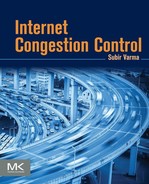Preface
Traffic congestion is a ubiquitous fact of modern life. Unbeknown to most people, the networks that constitute the Internet are also subject to congestion, albeit caused by data packets rather than autos. The distributed algorithms that keep this congestion under control form the subject matter of this book. Without these algorithms, the network can stop functioning altogether, a phenomenon known as congestion collapse, which is familiar to most people who are stuck in rush hour traffic.
The field of congestion control has seen many notable advances in recent years, but there is a lack of current books on this topic. The purpose of this book, which is targeted toward advanced and intermediate readers, is to inform about the most important developments in this area in the past 20+ years, with special emphasis on analytical modeling of congestion control systems. The book should also enable readers to gain a good understanding of the application of congestion control theory to a number of domains such as data center networks, video streaming, high-speed links, and broadband wireless networks. When seen through the lens of analytical modeling, a number of common threads run through the design and analysis of congestion control protocols in all these different areas, which to my knowledge have not been bought together in a single book before. I also hope this book will lead to a greater degree of cross-fertilization of ideas from these different application areas. By collecting the most significant results in the area of congestion control algorithms in one place, this book can serve as an impetus to new discoveries. For students, it cuts a path through the profusion of algorithms in the literature and puts the topic on a systematic and logical footing.
Some of the important features in the book include:
• A current and concise exposition of some of the most important topics in the area of congestion control for computer networks, with special emphasis on analytical modeling of congestion control systems
• Accessible coverage of the advanced topics of optimization and control theory as applied to congestion control systems
• Application of the theory to the problem of congestion control in a number of areas such as data center networks, video streaming, high-speed links, and broadband wireless networks
The book is primarily directed toward the following audiences:
• Engineers and researchers working in the area of computing systems and computer networking from companies in the computer networking, telecommunications (both wired and wireless) and video streaming industries and from companies that operate large data centers.
• Advanced to intermediate undergraduate and graduate students in electrical engineering and computer science. The book can be used for a graduate-level course on advanced topics in computer networking.
• A secondary audience is engineers, students, and researchers in related fields such as information sciences, operations research, traffic engineering, and manufacturing who also have an interest in congestion control.
The common mathematical framework that underlies most of the work in this book is that of “fluid flow” models of packet data networks. These average out the short-term stochastic fluctuations in quantities of interest such queue sizes and result in ordinary differential equations as a description of the system dynamics. This simplifies the analysis considerably while retaining the essential aspects of the system behavior. As a result, most of the book can be read with only knowledge of freshman-level calculus and some basic probability theory. Knowledge of control theory is needed to understand the results in Chapter 3 and sections of Part 2 of the book that delve into questions of system stability, and I have tried to cover the basics of control theory needed for the book in the Appendices.
Congestion control, along with packet scheduling, mobility, and medium access control, has dominated the work that I have been engaged in during the course of my professional career. Similar to many other authors, I started writing this book as a way of bringing myself up to date with the work in this field, and it has been a wonderful learning experience. The book has evolved over the past year as my own understanding of the subject increased, and this has considerably improved the material that is presented here. I have had the vantage point of surveying the past almost 30 years of work in this area and have chosen the results that have withstood the test of time. But as with any other author, the choice of topics is idiosyncratic, and in my case, biased toward work that can be put into an elegant theoretical framework. Most of the work has appeared in research publications, but in places, I have filled in gaps that I found, resulting in some new material.
